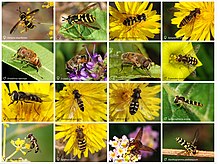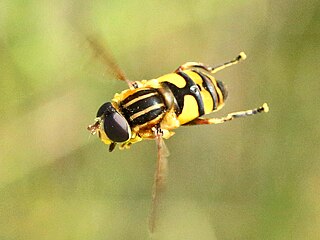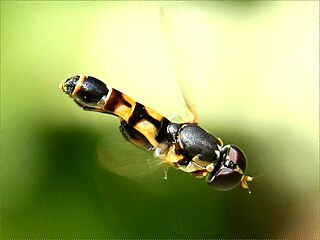Hoverfly
| Syrphidae Temporal range:
| |
|---|---|

| |
| Sixteen different species of hoverflies | |
| Scientific classification | |
| Domain: | Eukaryota |
| Kingdom: | Animalia |
| Phylum: | Arthropoda |
| Class: | Insecta |
| Order: | Diptera |
| Section: | Aschiza |
| Superfamily: | Syrphoidea |
| Family: | Syrphidae Latreille, 1802 |
| Subfamilies | |
Hoverflies, also called flower flies or syrphids, make up the
Insects such as
About 6,000 species in 200 genera have been described. Hoverflies are common throughout the world and can be found on all continents except Antarctica. Hoverflies are harmless to most mammals, though many species are mimics of stinging wasps and bees, a mimicry which may serve to ward off predators.
Hoverfly hovering behavior is unlike that of
- Adult hoverflies often hover over the plants they visit
Description
The size of hoverflies varies depending on the species.
With a few exceptions,[11] Hoverflies are distinguished from other flies by having a spurious vein, located parallel to their fourth longitudinal wing vein.[5] Adults feed mainly on nectar and pollen.[10] Many species also hover around flowers, lending to their common name.[5]
Bee flies of the family Bombyliidae often mimic Hymenoptera and hover around flowers, as well, rendering some bombyliid species hard to tell apart from Syrphidae at first glance. Hoverflies can, nevertheless, be distinguished in the field by anatomical features such as:[citation needed]
- The legs and mouthparts of hoverflies are usually not particularly long and thin (some bombyliids have a long and needle-like proboscis, many have legs that are noticeably longer and thinner than in similar-sized syrphids)
- Their facial cuticle often has prominent bulges and/or beak- to knob-like projections (most bee flies have an evenly curved or sloping face).
- The wings are often clear or have smooth gradients of tinting, and their veins merge posteriorly into a "false edge" that runs parallel to the wing's true rear edge and extends along half or more of the wing length (bombyliid wings lack a "false rear edge" and often have large dark areas with sharp boundaries, or complex patterns of spots).
- Their abdomens and thoraces often have glossy cuticular body surfaces, abdominal colors are usually mainly due to cuticular pigments (bee flies are usually very hairy, their abdominal colors are almost always due to pigmentation of hairs and not the underlying cuticle).

Reproduction and life cycle

Unlike adults, the

An example of a well-known hoverfly maggot is the

Very rarely, hoverfly larvae have caused accidental myiasis in humans. This occurs when the larvae are accidentally ingested from contaminated food.[13][15]
Evolution
The oldest known fossils of crown group
Distribution and habitat
Hoverflies are a
While some hoverfly larvae are aquatic and are often found in stagnant water, those of species that prey upon
Pollination


Hoverflies are important
Like many pollinator groups, syrphid flies range from species that take a generalist approach to foraging by visiting a wide range of plant species through those that specialize in a narrow range of plants.[22] Although hoverflies are often considered mainly nonselective pollinators, some hoverflies species are highly selective and carry pollen from one plant species.[23] Cheilosia albitarsis is thought to only visit Ranunculus repens.
Specific flower preferences differ among species, but syrphid fly species have repeatedly been shown to prefer white- and yellow-coloured flowers.[24] Nonvisual flower cues such as olfactory cues also help these flies to find flowers, especially those that are not yellow.[25] Many syrphid fly species have short, unspecialized mouth parts and tend to feed on flowers that are more open as the nectar and pollen can be easily accessed.[26]
Also, a number of interactions occur between orchids and hoverflies. The orchid species
Systematics
Relationship with humans

Adult syrphid flies are pollinators.
Larvae of many hoverfly species prey upon pest insects, including
Fredrik Sjöberg's book The Fly Trap concerns his enthusiasm for hoverflies on the island of Runmarö in the Baltic Sea.[30] The island is a hotspot for hoverflies and other insects; Sjöberg has collected 58 species of butterflies there, and (in seven years of hunting) 202 species of hoverflies, including 180 in his garden.[31]
Identification guides
- Skevington, J.H., et al., 2019. Field Guide to the Flower Flies of Northeastern North America. Princeton University Press ISBN 9780691189406. This book "covers all 413 known syrphid species that occur in or north of Virginia, Kentucky, and Missouri, west to include Iowa, Minnesota, Ontario, and Nunavut, and east to the Atlantic Ocean, including Greenland."
- Stubbs, A.E. and Falk, S.J. (2002) British Hoverflies An Illustrated Identification Guide. Pub. 1983 with 469 pages, 12 col plates, b/w illus. British Entomological and Natural History Society ISBN 1-899935-05-3. 276 species are described with extensive keys to aid identification. It displays 190 species on colour plates. 2nd edition, pub. 2002, includes new British species and name changes. It includes European species likely to appear in Britain. Additional black and white plates illustrate the male genitalia of the difficult genera Cheilosia and Sphaerophoria.
- van Veen, M.P. (2004) Hoverflies of Northwest Europe: Identification Keys to the Syrphidae. KNNV Publishing, Utrecht ISBN 9050111998.
- Miranda G.F.G., Young A.D., Locke M.M., Marshall S.A., Skevington J.H., Thompson F.C. (2013) Key to the Genera of Nearctic Syrphidae.
- Bot, S. and Van de Meutter, F. (2023) Hoverflies of Britain and North-west Europe: A photographic guide (Bloomsbury Naturalist). ISBN 978-1-3994-0245-3.
Regional lists
- List of hoverfly species of Great Britain
- List of the Syrphidae of Ireland
- List of flower flies of New Zealand
- List of the flower flies of North America
- Syrphidae of New York State
References
- .
- ^ Almohamad, Raki; Verheggen, François J.; HaubrugeUniv, Éric (2009). "Searching and oviposition behavior of aphidophagous hoverflies (Diptera: Syrphidae): a review". Biotechnologie, Agronomie, Société et Environnement. 13 (3): 467–481.
- ^ Vera Strader. "Hover Flies, a Gardener's Friend" (PDF). University of California Agriculture and Natural Resources.
- ^ Peter Chen (December 6, 2023). "Allograpta exotica ovipositing - Allograpta exotica - Female". Bugguide. Iowa State University.
- ^ a b c d e f g "hoverfly". Encyclopædia Britannica Online. 2009. Retrieved December 5, 2009.
- ISBN 1-899935-03-7.
- ISBN 1-870393-54-6.
- ISBN 90-5011-199-8.
- ISBN 9780691189406.
- ^ a b c d "Hoverfly". Hutchinson Encyclopedia. Helicon Publishing. 2009. Retrieved December 6, 2009.
- PDF). Zoologische Mededelingen. 82: 177–188.
- S2CID 85070615.
- ^ PMID 10475752.
- ^ Dictionary of Ichthyology; Brian W. Coad and Don E. McAllister Archived 2009-12-06 at the Wayback Machine at ww.briancoad.com
- S2CID 12898612.
- S2CID 91679754.
- ^ Barkemeyer, Werner. "Syrphidae (hoverflies)". Biodiversity Explorer. South Africa: Iziko Museum. Archived from the original on September 23, 2015. Retrieved December 11, 2009.
- ^ Thompson, F. Christian (August 19, 1999). "Flower Flies". The Diptera Site. United States Department of Agriculture. Archived from the original on December 11, 2009. Retrieved December 11, 2009.
- ISBN 978-0-12-372500-4.
- ^ Laura Smith. "Syrphidae, hoverflies". bumblebee.org.
- ^ S2CID 55767580.
- PMID 25754608.
- S2CID 9178645.
- ^ Sajjad, Asif; Saeed, Shafqat (2010). "Floral host plant range of syrphid flies (Syrphidae: Diptera) under natural conditions in southern punjab, Pakistan". Pakistan Journal of Biology. 42 (2): 1187–1200.
- S2CID 23245484.
- doi:10.1016/j.baae.2012.04.003.)
{{cite journal}}: CS1 maint: multiple names: authors list (link - PMID 20943694.
- PMID 19121110.
- ^ Ben-Issa, R., Gomez, L., & Gautier, H. (2017). Companion Plants for Aphid Pest Management. Insects, 8(4), 112. https://doi.org/10.3390/insects8040112
- ISBN 978-1-84614-776-0.
- ^ Barkham, Patrick (14 June 2014). "Fredrik Sjöberg: 'I realised I had to write my book for people not interested in flies'". The Guardian. Retrieved 15 March 2015.
External links
- Hoverfly Recording Scheme – UK Dipterists Forum
- Syrphidae species in Europe and Africa, with photos, range maps, checklists and literature
- Diptera.info Picture Gallery
Species lists
- Nearctic at nearctica.com
- West Palaearctic including Russia at faunaeur.org
- Australasian/Oceanian at bishopmuseum.org
- List of the flower flies of North America
- List of hoverfly species of Great Britain
- Syrphidae of New York State
- List of flower flies of New Zealand




